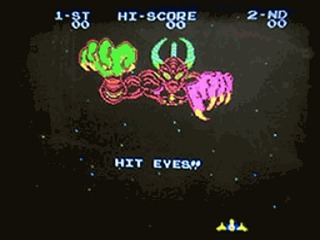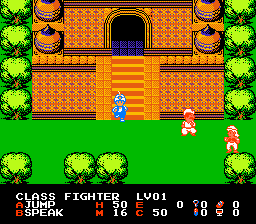Overview
Founded in 1980 by Yukio Tanaka (first as "Nihon Game Company", a.k.a. "Taiyo System"), Culture Brain Excel is a small developer/publisher based in Tokyo that got its start in arcade game development. The company made a handful of successful games on the Famicom and Super Famicom, but didn't manage the transition to later generations. These days Culture Brain develops and publishes low-cost games, mostly for children, on Nintendo handhelds. Their website has not been updated since 2017.
The company was renamed Culture Brain Excel, from Culture Brain, in 2016.
History
Arcade (1981-1985)
 Monster Zero
Monster ZeroAccording to an "Insider's Guide to the Nintendo World Championships" published in 1990 by Nintendo themselves, Culture Brain (which was then Taiyo System) helped Nintendo develop the landmark original arcade game Donkey Kong in 1981. Taiyo's first independent release was the shooter Monster Zero (1982), a Japanese hit. Through the early 80s Taiyo continued to release arcade titles that did well. Chinese Hero (1984) was a popular top-down single-screen beat-em-up, and Shanghai Kid (1985), one of the earliest fighting games, was arguably the first to introduce a sort of combo system. "RUSH!" would appear on the screen and you'd have to make a series of fast attacks on highlighted locations on your opponent's body.
The Golden Age (1986-1989)
 The Magic of Scheherazade (NES)
The Magic of Scheherazade (NES)With the launch of the Famicom, Taiyo System renamed itself to Culture Brain and doubled down on working with Nintendo, porting their major hits for the home. Chinese Hero, with few changes, became Kung-Fu Heroes (1986) on Nintendo's console, and Shanghai Kid had side-scrolling levels added onto it and became Flying Dragon: The Secret Scroll (1987). Both sold well in Japan.
Following on their domestic success, Culture Brain USA was established for localization work. The US branch of the company put a lot of work into graphical and gameplay changes to the Japanese games to adapt them to the Western market, and in that golden age, Culture Brain did take a few risks, weaving story and character around their original basic game concepts.
Their first big foray was a surprisingly unique action RPG, The Magic of Scheherazade (1987 JP, 1989 NA). Similar to The Legend of Zelda on its surface, Scheherazade mixes magic, turn-based fighting, realtime action, RPG stats, levelling, and a story that was at times dark, wry, and surprising, all in a fantasy Arabian setting.
 Little Ninja Brothers (NES)
Little Ninja Brothers (NES)Kung-Fu Heroes found another life as Little Ninja Brothers (1989, aka Super Chinese in Japan). A different take on the action RPG, LNB had an overworld, towns, equipment, a long story, themed areas, and turn-based boss battles, but the usual RPG random encounters dropped you into the beat-em-up gameplay of Chinese Hero - and there were even arcade-style, track-and-field PvP competitions as minigame interludes in the story.
Then Flying Dragon was developed into Flying Warriors (1991, aka Hiryu no Ken), a combination platformer, RPG, and fighting game where members of an elite fighting force (though in the localized Western version they were turned into superheroes) who are combatting an evil menace while simultaneously participating in international fighting tournaments as their "normal" alter-egos. The arcade style fighting came straight from Shanghai Kid.

Finally, Culture Brain's biggest departure from their past is arguably Baseball Simulator, but you can see the parallels: once again, they took some old mechanics and put them in a totally different context. This time, yes you hit balls with bats, but they added in fantasy superhero elements like fireballs, earthquakes, and other wild abilities. (In Japanese, titles in this series usually had Chōjin in the name - "Superman" - but for obvious copyright reasons that wouldn't really fly in America. Or even leap tall buildings.) Baseball Simulator ended up being very successful in both regions. Baseball Simulator 1.000 for the NES won newly launched Electronic Gaming Monthly's Best Sports Game of 1989.
Fading into the Background (1990-)
 Hamster Monogatari 64.
Hamster Monogatari 64.Unfortunately for Culture Brain and for players, after the NES era, the company settled in to a habit of uninspired rehashes of their past successes. Through the 90s, the company churned out new entries to their core series, but they continued to be very familiar iterations of the old games even down to minor plot details, with most of the changes limited to tweaks and graphical overhauls.
There are SNES and N64 versions of each of their Famicom games (except Scheherazade) which follow almost exactly the same structure every time. On top of that, each iteration tended to trim away the hybrid gameplay, making the new versions much less exciting or attention-getting than their predecessors. Few of their later releases made it to North America. They made one PlayStation release, Virtual Hiryu no Ken in 1997, and that was pretty much it for old Culture Brain.
From 2000 onward, they concentrated on three young children's games series, mostly for handhelds - Hamster Monogatari, Konchuu Monster, and Oshare Princess.
In 2014 they took another kick at the Baseball Simulator can and released a couple of small card battler games in the series for 3DS, and in 2016-17 they put out two Chōjin Baseball Stadium games for the 3DS -- baseball games with some RPG elements -- for about 500-yen (about $5 USD) each.
Trivia
Many Culture Brain games are credited to "Yumenosuke Project" or "Yumenosuke Academy", instead of any specific person inside the company, following the early Japanese industry practice of not disclosing the names of developers so that they couldn't be hired by other companies. One way yumenosuke could be literally translated is "assistants of dreams".
Until 2003(?), they had a vocational school, the Culture Brain Computer Art School.
Log in to comment